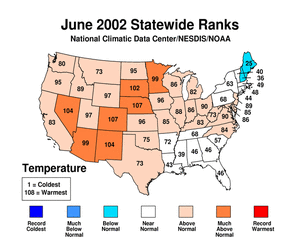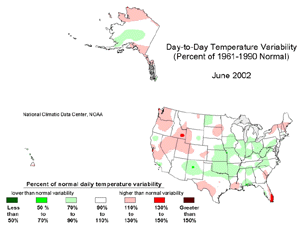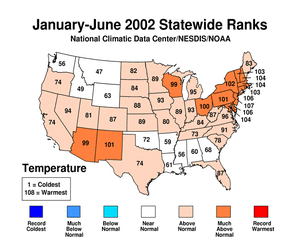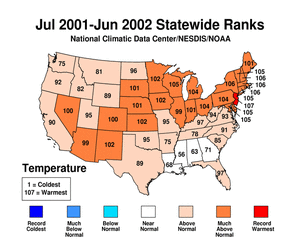National Temperatures
larger image The graph to the left shows monthly mean temperature averaged across the contiguous United States based on long-term data from the U.S. Historical Climatology Network (USHCN). The value for 2002 is estimated from preliminary Climate Division data using the first difference approach. June 2002 ranked as the 5th warmest June in the 1895 to present record. The preliminary nationally averaged temperature was 71.6° F (22.0° C) which was 2.3° F (1.3° C) above the long-term mean. The June temperature values from 1895 through 2002 are available.
Much above average warmth occurred in 7 states in the southwest and northern plains in June. Both Colorado and Nebraska had their second warmest June on record. June temperatures in Alaska were also above average, making it the 17th consecutive June with warmer than average temperatures in that state. Cooler than average mean temperatures were limited to the far northeast (Maine and New Hampshire). The pattern of warmth and cold in the contiguous U.S. in June corresponds well with the mean 500mb height and anomalies chart. Above normal mean 500mb heights existed in a broad band across the center of the U.S., with the largest anomalies occurring in the far northeast corner of Nebraska and northwest Iowa. Cooler than average surface temperatures were associated with slightly lower than average 500mb heights in the far northeast. The pattern of state-averaged monthly temperature can be seen in the map to the right. A more detailed analysis including how statewide and regionwide temperatures compare to other years is available.
larger image
Temperature Departures
The map to the right, based on over 500 airport stations, shows departures from the 1971-2000 normal temperatures for June 2002. Much warmer than average temperatures extended from Arizona to South Dakota with the largest positive departures in the contiguous U.S. (greater than 5.4° F [3° C]) occurring in the Plains states of Nebraska and Kansas. Positive departures of greater than 7.2°F (4.0°C) were also recorded in southwest Arizona. The largest negative temperature anomalies were observed along coastal regions of California and the northeast U.S., with some cooler than average temperatures also occurring in the southeast, the Upper Peninsula of Michigan and parts of the West North Central region. The most significant negative departures occurred in Maine, New Hampshire and Vermont where temperatures were below normal by more than 3.6°F (2.0°C).
larger image
larger image The day-to-day variability of daily mean temperature was up to 110-150% of normal over northern Utah, southern Idaho and Nevada, as well as Washington and Oregon in June. This was associated with a series of alternating cold and warm outbreaks throughout the month, as can be seen in an animated map of daily temperature anomalies. Especially noticeable in the animation is the contrast between June 9 (when negative departures were as much as -20°F [11.1°C] in northern Utah), and June 13-15, (when temperatures were above average by over 4°F [2.2°C] in the same area). Slightly below average temperature variability was notable from New Mexico to Pennsylvania where day-to-day variability was less than 90% of average.
National Precipitation
larger image The graph to the left is a time series depicting precipitation averaged across the contiguous U.S. Based upon preliminary precipitation data, June 2002 was drier than average, ranking 28th driest. June 2002 marks the first June in nearly a decade that has been significantly drier than average. Nationally averaged June precipitation shows no significant trend over the last century.
There was considerable regional variability in precipitation across the country. States in the southwest U.S. continued to receive less rainfall than average in June, while states in the northeast received additional beneficial rains this month helping to ease their long-term drought conditions. Florida also received substantial rainfall from showers and thunderstorms that developed almost daily over portions of the state, and led to a rank of 6th wettest June on record. Arizona had its 2nd driest June in the 1895-present record which marks the 10th consecutive month of below average precipitation for the state. More information on the southwest drought can be found here A more detailed analysis including how statewide and regionwide precipitation compares to other years is also available.
larger image
Precipitation Anomalies
The map to the right, based on more than 500 airport stations, shows June 2002 total precipitation as a percent of the 1971-2000 station normals. Above normal precipitation generally occurred in the far southeast and northeast, with more than 180% of normal precipitation also falling in parts of Montana, North Dakota, Minnesota and Wisconsin. The rest of the country was mostly dry, including, most notably, California and the southwest, also south and west Texas. The primary weather stations on the islands of Hawaii were also drier than normal for June.
larger image
Hurricane Season
larger image Hurricane season in the Atlantic begins on June 1st. The map to the left shows sea-surface temperatures for the Atlantic averaged over the period 16th-22nd of June. In order for tropical waves to develop into tropical storms and hurricanes, sea surface temperatures generally need to be above 26°C (78.8°F). As is evident in the map, the Gulf of Mexico and Caribbean Sea region as well as much of the western tropical Atlantic have warm enough SSTs for hurricane formation to occur. However, other atmospheric conditions have not been favorable for tropical storm development, consequently in June 2002 there was no tropical storm or hurricane activity.
On average only one named system (tropical storm strength or greater) forms in June in the Atlantic basin, so the lack of activity in June is not unusual. In 2001, however, Tropical Storm Allison formed in the Gulf of Mexico on June 5 and became the costliest tropical storm in U.S. history causing around $5 billion in damage. This was principally due to the intense rainfall accompanying the slow-moving storm. Rainfall totals for June 4-10, 2001 for coastal Texas and Louisiana can be seen on the map to the right.
larger image
Wildfire Season
larger image Due to ongoing drought, the western wildfire season in the U.S. has so far been both active and early compared to average. As of the end of June according to the National Interagency Fire Center, there were nearly 2.8 million acres burned this year. The (ten-year) average number of acres burned by June 30th is only around 1.1 million acres. The 2001 fire season was near average (though it began somewhat later than usual), however, the 2000 fire season was one of the worst of the last 50 years. The acreage burned so far in 2002 has surpassed the extent of land destroyed by fire by June 30th in 2000 by around 1.2 million acres.
While some of this year's fires were started by lightning, many were reportedly started by human activities as a result of accident or arson. Most of the large fires in June occurred in Colorado, Arizona and New Mexico, with significant wildfire activity also in evidence in Utah, California, Georgia and Virginia. Further information on this year's fire season can be found on NCDC's drought pages and at the National Interagency Fire Center's web-site.
larger image
National Temperatures - January-June 2002
larger image The graph to the left shows 6-month mean temperature averaged across the contiguous United States based on long-term data from the U.S. Historical Climatology Network (USHCN). The value for January-June 2002 is estimated from preliminary Climate Division data using the first difference approach. January-June 2002 ranked as the 16th warmest such period in the 1895 to present record. The preliminary nationally averaged temperature was 49.7° F (9.8° C) which was 1.4° F (0.8° C) above the long-term mean.
Statewide mean temperatures for the first six months of 2002 were above average for Arizona, New Mexico as well as most northeastern states. The pattern of warmth and cold in the contiguous U.S. in this period corresponds well with the mean 500mb height and anomalies chart. This shows that above normal 500mb heights existed across the southern tier of the country, with the largest positive anomalies over the continental U.S. occurring in the mid-Atlantic states. However, south of Alaska, over the northeastern Pacific, positive anomalies greater than 70 meters led to a statewide positive January-June temperature departure of 3.9°F (2.2°C) for Alaska. No state had cooler than average mean surface temperature for the January-June period, despite extensive cooler than average conditions in March and May 2002. A more detailed analysis including how statewide and regionwide temperatures compare to other years is available.
larger image
National Precipitation - January-June 2002
larger image The graph to the left is a time series depicting precipitation averaged across the contiguous U.S. Based upon preliminary precipitation data, January-June 2002 was drier than average, ranking 13th driest in the last 108 years. This is the driest January-June since 1988.
Record dryness occurred in Arizona, Utah and Colorado averaged over the period January-June, 2002. Six other states in the west (CA, NV, NM, WY, SD, NE) and one state in the east (NC) also received much below average precipitation. Arizona has received below average precipitation in each of the last 10 months. States in a broad band from Arkansas to New Hampshire received above or much above average precipitation averaged over the first six months of 2002. This is in stark contrast to the last six months of 2001, when northeast precipitation was much below normal and the region was suffering from severe drought. A more detailed analysis including how statewide and regionwide temperatures compare to other years is available.
larger image
National Temperatures - July 2001-June 2002
larger image The graph to the left shows monthly mean temperature averaged across the contiguous United States based on long-term data from the U.S. Historical Climatology Network (USHCN). The value for the last 12 months is estimated from preliminary Climate Division data using the first difference approach. July 2001-June 2002 ranked as the 4th warmest such period in the 1895 to present record. The preliminary nationally averaged temperature was 54.5°F (12.5°C) which was 1.7°F (0.9°C) above the long-term mean.
Record statewide warmth, averaged over the last 12 months, occurred in New Jersey. The pattern of state-averaged monthly temperature can be seen in the map to the right. Twenty-four other states ranked in the top ten warmest such periods. Only 4 states (LA, MS, AL, GA) maintained near-average temperatures for July-June. A more detailed analysis including climate division maps and information, and how statewide and regionwide temperatures compare to other years is available.
larger image
National Precipitation - July 2001-June 2002
larger image The graph to the left is a time series depicting precipitation averaged across the contiguous U.S. Based upon preliminary precipitation data, July 2001-June 2002 was drier than average, ranking 28th driest in the last 108 years. This is the third consecutive July-June that has had below average precipitation, but this follows a decade of generally wetter than average conditions for the contiguous nation. The century-scale trend for July-June precipitation is 0.2 in/decade.
Record dryness occurred in Colorado and the Carolinas from July 2001-June 2002. Near record dryness also occured in the southwest states and much of the Atlantic seaboard. Downtown Los Angeles recorded its driest water year (Jul-Jun) on record with a total of just 4.42 inches (29% of normal), and Palm Springs received only 8% of normal rainfall for the same period. A time series of precipitation departures for climate division 6 in California (which encompasses the coastal LA area), shows that not one month in the last 12 has averaged above the long-term mean monthly rainfall. In contrast, Indiana had its wettest July-June on record and the entire Ohio and Tennessee River Valleys region received above or much above average precipitation. A more detailed analysis including how statewide and regionwide temperatures compare to other years is available.
larger image
 NOAA's National Centers for Environmental Information
NOAA's National Centers for Environmental Information


















